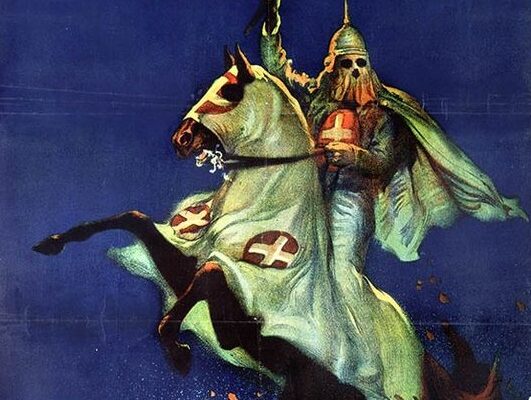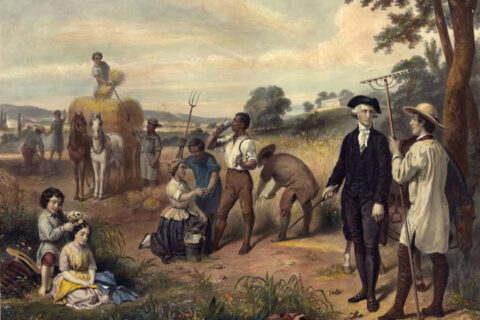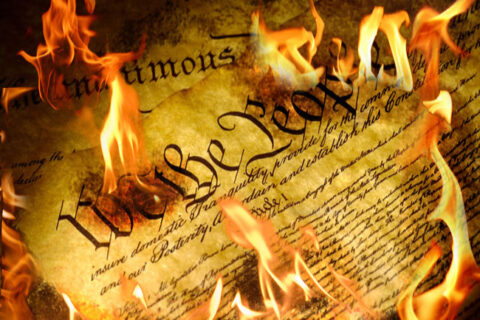Author's Preface: For this piece, I would like to provide a bit of pretext. The topic in question is being analyzed, not endorsed. I have made painstakingly sure that the diction I used in this essay conveys my opposition to reprehensible behavior. Any actions committed by the group to be discussed are hereby not endorsed by myself or Identity Dixie; however, the infamy and constant media proliferation of this negative stereotype of Southerners and their history needs analysis and historic context. Public institutions employ a similar excuse to the media in order to remove any public displays of Confederate imagery despite the excuse largely being based upon lies and myth perpetuated by a hostile mainstream media and a contemporary Reconstructionist regime.
Many macabre topics haunt the story of Dixie. Of all the regions which comprise North America, the South remains the most beleaguered by its past. Casting a dark shadow over a once cultured, proud people, Dixie’s history consists of heinous stories filled with brutality, poverty, tumultuous circumstances, and political unrest. The civilizing of the bestial, ravening Deep South, ruthless bloodshed of the War Between the States, proto-Communistic Radical Reconstruction, a long history of violence, lynchings, secret societies, general lawlessness, and the direful Civil Rights Movement all characterize Dixie’s image and defined much of its identity. However, one key component of the South’s dark history stands tantamount to the rest, drawing the relentless ire of educational propagandists and the mainstream media, as well as, constant condemnation of political figures. This ever present curse grows from the infamy of none other than the Ku Klux Klan. Consistently utilized as an excuse to continue the Reconstruction of the South despite no longer existing, the Ku Klux Klan has been a staple of American political discourse since its inception in 1865. This essay seeks to analyze the multiple eras of the Klan whilst providing a chronological history of the process.
Dating as far back as the time immediately following the War Between the States, the Ku Klux Klan founding remains a mystery. Sources indicate the Klan may have been founded on 24 December 1865, while others indicate the Klan may have formed as late as March 1866. Regardless, the group definitely began its initial iteration shortly after the War’s end between December 1865 and March 1866. Pulaski never grew to be much more than a town, and there were some Negroes in the area but not enough to instill a major social effect on the locales. Boredom prevailed among the populace, as the downtown area received some damage during skirmishes in 1862. Six former Confederates congregated together to form the Ku Klux Klan as a fraternal organization largely for the purpose of practical jokes and mischief. Despite the constant push and endorsement of the group by the newspaper The Pulaski Citizen, the fraternity stayed largely unknown and unheard of until 1867, not longer after adopting its very own prescript and the passage of the Reconstruction Acts.
Around that time, word of the mysterious Klan began to spread, and a number of Southerners filled its ranks. Unfortunately, the name took on a new meaning. Many lower class whites utilized the name and style to exert political force within their respective localities. Utilizing minstrel and carnivalesque style, Klansmen carried out numerous night raids across the former Confederacy and often posted warnings in towns or on houses before such incursions occurred. Until 1868, these raids were meant as ploys to influence voting patterns or police their local communities via vigilante justice. Organized into local “lodges,” Klansmen generally avoided calls for centralization by leadership of the national organization, and many decided instead to remain local, making it easier to carry out nightly actions and harder to trace. During these escapades, Klansmen would imitate a variety of things. Many dressed as and pretended to be women. Others commonly masqueraded as animals. The most popular to imitate were ghosts. Many Klansmen often showed up to Negro houses out of seemingly nowhere and claimed to be spirits of deceased Confederates, applying a multitude of antics to simulate such a character. These subterfuges solidified the Klan’s ghostly image it came to be known for, despite the variety of costumes used; additionally, it played on the Negroes heightened superstitious nature and permanently implanted the Klan into folkloric legend.
Politically, the Klan only found success in Georgia, effecting enough influence to have the state vote Democrat in the 1868 presidential election. Following the election, the various chapters’ priorities altered a bit. They became more extreme and less focused on policing, instead opting to attack high profile politicians, harass and murder Negroes, and engage in warfare against state troops in a few areas. The federal government began a process of prosecuting Klan activity, increasing troop occupation as a result. This 1st Klan had totally dissolved by 1871. Though the paramilitary successes of Redeemer Democrats in the 1870s squarely rest on the shoulders of the Red Shirts in Mississippi and South Carolina and the White League in Louisiana, the Ku Klux Klan never ceased to exist within the oral history of the South, and many viewed them as heroes against Radicalism.

Despite common assertions that the Klan manifested as a means for Caucasians to reinstate the Antebellum Society, the group itself was quite modern, for the time, and it also permeated most intensely in the Hill Country, areas lacking in Anglo stock and former Planter Aristocracy. Borrowing from various clothes, styles, entertainments, other fraternities, and cultures in vogue at the time, the Klan’s original foundation in no way sought to reinstate the Old South. The main purveyor of early pro-Klan sentiment and part of its founding, The Pulaski Citizen, supported Whiggism and was not all too friendly to secession in 1860, as was common among locals in the area. Even at the height of the Klan crisis in 1869, the “lodges” were primarily regulated to the Unionist and formerly Whiggish stronghold Appalachia, mostly concentrated in Piedmont regions and areas where Negroes and Appalachians lived in close proximity. The minstrelsy and carnivalesque also permeated within modern culture and were used as a means of display when raiding or intimidating Radicals and Negroes.
Having solidified itself within local folklore as heroes of the Southern struggle against Reconstruction, the former Klan still remained a topic of discourse among Southerners. However, the organization would not see a resurgence until the late 1910s. Being wholly nonexistent outside of local legend, William Joseph Simmons created a new Ku Klux Klan at Stone Mountain, Georgia in 1915, having been inspired by the recent release of the groundbreaking film Birth of a Nation. Slow to start but well organized, the KKK grew rapidly in 1920 after the Great War’s closure and the continued growth of American cities. By this time, a steady tidal wave of Southern and Eastern European immigrants had moved into the country since the 1890s, Prohibition had taken place, urbanism thrived, 1920s culture thrived in degeneracy, and white Protestant consciousness was peaking. Reacting against urbanism and the degeneracy it introduces, unfavorable immigrants, and alcoholism, the newly formed Knights of the Ku Klux Klan seized the fascination of America.
Many World War I veterans joined as did a number of nativists in proximity to large cities with the highest concentration of members being in the Midwest, Texas, Florida, and Oregon. Unlike popular belief, the organization did not find much support in the Deep South. Focusing on Protestant Christianity and American Nationalism, the Klan grew to heights which left it powerful enough to exert political influence for decades, even after the beginning of its decline. By 1925, the group held between three million and six million members and had numerous politicians on its payroll. Despite the aforementioned social situation and popularity, violence reigned high throughout the United States.
The Red Summer, Tulsa Race Riot, and relentless civil unrest fueled media propaganda. Additionally, the conviction of D.C. Stephenson, the Indiana Grand Dragon, for the rape and murder of Madge Oberholtzer, single handedly began the decline of the 2nd Klan. Continued controversies, the Great Depression, and media propaganda bled membership and, ultimately, resulted in the total close of the organization in 1944. The 2nd Klan presented a formidable force in American politics and established the classic image of the Ku Klux Klansman.

The 3rd Klan began in the 1950s following the Brown v. Board of Education Supreme Court ruling. Decentralized in a manner similar to the 1st Klan, but donning the imagery and language of the 2nd Klan, the 3rd Klan erupted onto the socio-political scene in a display of reprehensible extremism and violence. Incorporating the use of American and Southern imagery, the 3rd Klan started the trend of giving the American Right a negative name. These local Klans sought to resist desegregation and the scaling back of Jim Crow Laws. Whereas political involvement, Citizens’ Councils, and networking were seen as the white collar means of opposing desegregation, this Klan sought to provide blue collar whites a means of resisting integration. Lower class whites found themselves caught in the middle of a conflict in which they had no say on the matter. Negroes climbed the social ladder with the backing of the federal government, and statesmen split over the issue with some championing Jim Crow Laws and others working diligently to usher in the New South. Claiming to also oppose degeneracy and lawlessness, the 3rd Klan faced difficulty maintaining its image due to the murders by members of the Klan, often individuals operating on their own. Alongside these murders, government crackdowns took place in order to indict members and weaken resistance to Civil Rights legislation. The 3rd Klan ultimately ended in 1968, once the Civil Rights Movement drew to a close.
The effect on society this wave carries may still be felt today, more so than the combined effect of the first two iterations of the Klan. Concentrated in the Lowland, Klan activity during this time solidified the stereotype of associating it with the Deep South. The most violent and notorious of Klan organizations operated within the Lowland irrespective of the widespread participation in opposition to desegregation. The Original Ku Klux Klan of the Confederacy in North Alabama, the United Klans of America in Alabama and Georgia, and the White Knights of the Ku Klux Klan in Mississippi instigated reigns of terror across the Lowland and committed the most heinous racially and politically motivated crimes of the time. The OKKKC broke away from the Alabama Citizens’ Council and lasted from 1956 to 1958, believing the Citizens’ Councils to not be extreme enough. The UKA’s domain extended from Alabama to as far north as North Carolina and was responsible for Birmingham being nicknamed “Bombingham.” It formed in the early 1960s from the combining of multiple Klans within the region and reached as many as about 30,000 to 40,000 members at its peak. The Mississippi White Knights formed in 1964 under the tutelage of Samuel Bowers and reached a peak of several thousand in the state it operated solely within. Being responsible for a multitude of atrocities and assuming the crimes were not staged by the federal government, the White Knights’ most infamous act was the Freedom Summer Murders of carpetbaggers Andrew Goodman and Michael Schwerner and native Negro James Chaney.
The Ku Klux Klan never experienced much resurgence following 1968. An arguable 4th Klan began under the leadership of David Duke in the mid-1970s, but assuming this was a fourth wave, it laughably did nothing and had failed in spectacular fashion by 1985. The Klan has effectively ceased to exist with none operating after the 1990s due largely to constant media scare tactics and unfaltering federal lawsuits and trumped up charges. In the 1960s, when unable to gather evidence or convict a Klansmen, government agencies would subpoena the charismatic leadership and demand evidence Klansmen were obviously never going to produce, sentencing them to just enough time in federal prison once preposterous demands could not be met and causing the state chapters to disintegrate. In addition, and as vaguely hinted at, the federal government began heavily infiltrating dissident organizations and manipulating them into committing gruesome acts so as to provide reason to indict.
In other cases, federal agents most likely committed the acts themselves and framed them on dissidents, a precedent that still exists and makes dissident activism largely a joke or hilariously pointless. The government and media have done such an effective job of infiltrating and crippling the Klan over the past few decades that the groups no longer exist. It is mostly “smoke and mirrors” as the saying goes and largely serves the purpose to keep the public’s eye on the boogeyman of white racism. Assuming any real Klans still exist, they are largely small groups of friends of blue collar background who get together and burn a cross; that is it. The only Klans which supposedly still exist in any capacity are the Loyal White Knights based in North Carolina, the American Christian Dixie Knights based in Tennessee, and the Imperial Klans of America in Kentucky; again, their existence is largely conjecture and may simply be government operators or contractors. Not even the Mississippi White Knights exist anymore, yet the SPLC and other databases claim the state rests as the number one state in Klan activity.
The main purveyor of Dixie’s negative reputation, an in-depth study of the Klan’s lifespan, reveals a history mired in nuance and complexity, as well as, grisly brutality and macabre violence. Despite the insistence from news outlets that the Klan is alive and well, evidence suggests the contrary. Utilized as a scapegoat for the current hysteria involving Confederate and Southern imagery, the KKK continues to haunt the reputation of Dixie and serves as the excuse for the extermination of the Southern people and their culture. The history of this organization provides Southerners with no means of redemption from their sins and no solace from endless propaganda and traitorous politicians. The story of Dixie bears an insurmountable weight and carries the egregious affliction of draconian race relations, validity notwithstanding. Unable to come to terms with this past and adapt to the Radical Left’s ever changing tactics, Southerners are held in a state of regress, lack of adaptation in defense of Southern culture, ethnic replacement, and political disfranchisement, all for the sake of a sinister fraternal order which failed to endure the test of time. The memory of the Ku Klux Klan is now nothing more than that of a ghost of an old, dead South.
Former Imperial Wizard of the UKA Robert Shelton in 1994 lamenting the death of the Ku Klux Klan
"The Klan is my belief, my religion. But it won't work anymore. The Klan is gone. Forever."
“The White people of the South are the greatest minority in this nation. They deserve consideration and understanding instead of the persecution of twisted propaganda.” –Strom Thurmond






Well done.
FYI … the symbol is NOT christian … It’s far far more ancient … it is an extremely ancient navigational tool from Hyperborea …
Wut
The original Klan was a fraternal, benevolent self defense organization. In fact, it founded many higher institutions of education. The Reconstruction militias of the occupation governments and Union Leagues sorely oppressed Southerners – including murder – the Confederate veterans reacted – quite successfully – in fact so successfully (contrary to the tone of this article) that Reconstruction was broken and White’s retook control of their State governments instituting laws that benefited Southerners until the Communist Revolution initiated by Eisenhower in the late 1950’s. The Klan of the 1920’s era is best remembered for smashing the growing Communist movement fomented by the Jews who had immigrated to the US in huge numbers beginning in the 1890’s. Now, there is no organization that stands in their way and we are witnessing the decline and fall of Lincolns nation, created in 1865 and couldn’t survive more than 150 years.
It’s amazing how long of a shadow the Klan still casts in the minds of the SJW community. It’s like Southerners are expected to be eternally repentant for existing and having a unique regional identity.
The Irgun Movement under the greater umbra of Zionism did even worse to found the State of Israel.
https://www.washingtonpost.com/opinions/assessing-role-of-terrorism-by-jewish-underground-in-founding-of-israel/2015/03/13/9ac811fe-b938-11e4-9423-f3d0a1ec335c_story.html
https://www.britannica.com/topic/Irgun-Zvai-Leumi
https://www.britannica.com/topic/Stern-Gang
Great essay. I hope RY does a deep dive on the history of the Klan as well.
That would be cool…but maybe a bit too spicy of a topic.
We have been a beaten people for 160 years. These iterations of the klan were some of the death throes of a dying people. Our ancestors would be ashamed to see what has become of the South and of Southerners. Like the Samnites of Italy, they fought the good fight but ultimately were absorbed into the Roman collective. I don’t have a clue of how to fight the federal behemoth, but I’m a proud southerner and my children are too.
The only state the Klan actually took over was Indiana. In any event, Southerners have no reason to be ashamed of the Klan, or anything else. On the other hand, the systematic destruction of the South, which took more than 160 years, is one of the most genuinely evil episodes in history. That Iranian fellow who used to call the United States “the Great Satan” was correct.
You are referring to the 1920’s Klan. The Original Klan “took over” most of the State governments of the South or otherwise had a very overpowering influence. I expect too many of today’s Southerner to be apologetic and dismissive of the past, but if the Confederate Generation (the best of all) hadn’t had the will and grit to over come adversity the South today would look like the Bahamas. But it’s getting there pretty fast now anyway – lots of mulattoes – don’t you know.
The 1st Klan served a valuable purpose, resisting Federal occupation of the South. But now the media ‘Klan’ image is dragging us down. Atrocity stories erode support- all we hear about is those ‘four little girls’ killed in Birmingham, and more recently, Dylann Roof. We have to have more of our own media, we need regular in-real-life meet-ups, a normie friendly organization that can appeal to the young, and more liaison with politicians. Do you know anyone who has ever met a Congressman in person to advocate for white rights? How often has our side ever called in to a mainstream radio show, or C-Span ?